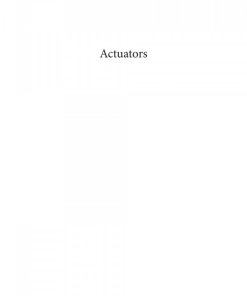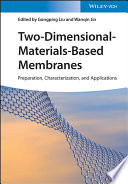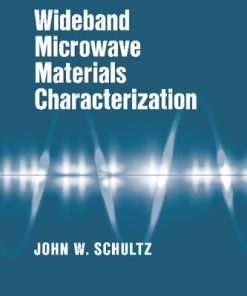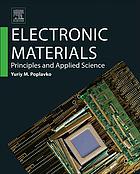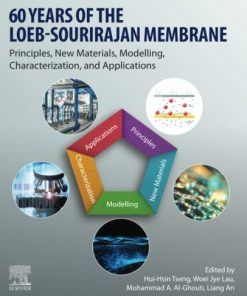(Ebook PDF) Principles of Materials Characterization and Metrology 1st Edition by Kannan Krishnan 0192566083 9780192566089 full chapters
$50.00 Original price was: $50.00.$25.00Current price is: $25.00.
Principles of Materials Characterization and Metrology 1st Edition by Kannan M. Krishnan – Ebook PDF Instant Download/DeliveryISBN: 0192566083, 9780192566089
Full dowload Principles of Materials Characterization and Metrology 1st Edition after payment.
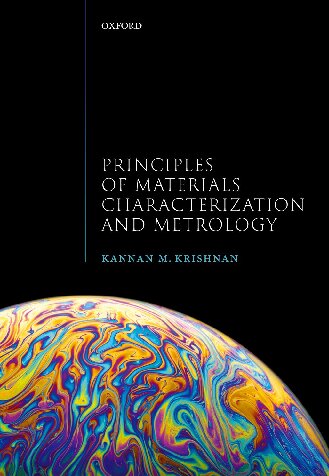
Product details:
ISBN-10 : 0192566083
ISBN-13 : 9780192566089
Author: Kannan M. Krishnan
Characterization enables a microscopic understanding of the fundamental properties of materials (Science) to predict their macroscopic behaviour (Engineering). With this focus, Principles of Materials Characterization and Metrology presents a comprehensive discussion of the principles of materials characterization and metrology. Characterization techniques are introduced through elementary concepts of bonding, electronic structure of molecules and solids, and the arrangement of atoms in crystals. Then, the range of electrons, photons, ions, neutrons and scanning probes, used in characterization, including their generation and related beam-solid interactions that determine or limit their use, is presented.
Principles of Materials Characterization and Metrology 1st Table of contents:
1: Introduction to Materials Characterization, Analysis, and Metrology
1.1 Microstructure, Characterization, and the Materials Engineering Tetrahedron
1.2 Examples of Characterization and Analysis
1.2.1 Ni-Based Superalloys: Ultrahigh Temperature Materials for Jet Engines
1.2.2 Unraveling the Structure of Deoxyribonucleic Acid (DNA)
1.2.3 Characterizing a Picasso Painting Reveals Hidden Secrets
1.2.4 Failure Analysis: Metallurgy of the RMS Titanic
1.2.5 Beneath Our Feet:Microstructure of Rocks and Minerals
1.2.6 Ceramic Materials: Sintering and Grain Boundary Phases
1.2.7 Microstructure and the Properties of Materials: An Engineering Example
1.3 Probes for Characterization and Analysis: An Overview
1.3.1 Probes and Signals
1.3.2 Probes Based on the Electromagnetic Spectrum and their Attributes
1.3.3 Wave–Particle Duality
1.3.4 Nature and Propagation of Electromagnetic Waves
1.3.5 Interactions of Probes with Matter and Criteria for Technique Selection
1.3.5.1 Penetration Depth and Mean Free Path Length
1.3.5.2 Resolution
1.3.5.3 Damage
1.3.5.4 Specimen Preparation or Requirements
1.4 Methods of Characterization: Spectroscopy, Diffraction, and Imaging
1.4.1 Spectroscopy: Absorption, Emission, and Transition Processes
1.4.1.1 Characteristic X-Ray Emission
1.4.1.2 Non-Radiative Auger Emission
1.4.2 Scattering and Diffraction
1.4.3 Imaging and Microscopy
1.4.4 Digital Imaging
1.4.4.1 Image Acquisition, Digitization, and Storage
1.4.4.2 Pre-Processing: Look-Up Tables, Histogram Equalization, Point, and Kernel Operations
1.4.4.3 Image Segmentation
1.4.5 In Situ Methods Across Spatial and Temporal Scales
1.5 Features of Materials Used for Characterization
Summary
Further Reading
References
Untitled
2: Atomic Structure and Spectra
2.1 Introduction
2.2 Atomic Structure
2.2.1 Bohr–Rutherford–Sommerfeld Model
2.2.2 Quantum Mechanical Model
2.3 Atomic Spectra: Transitions, Emissions, and Secondary Processes
2.3.1 Dipole Selection Rules and Allowed Transitions of Electrons in Atoms
2.3.2 Characteristic X-Ray Emissions and their Nomenclature
2.3.3 Non-Radiative Auger Electron Emission
2.3.4 Electron Photoemission
2.4 X-Rays as Probes: Generation and Transmission of X-Rays
2.4.1 Laboratory Sources and Methods of X-Ray Generation
2.4.2 X-Ray Absorption and Filtering
2.4.3 Synchrotron Sources of X-Ray Radiation
2.5 X-Rays as Signals: Core-Level Spectroscopy with X-Rays
2.5.1 Instrumentation for Detecting X-Rays
2.5.1.1 Wave Length Dispersion Spectrometer (WDS)
2.5.1.2 Energy Dispersive X-Ray Spectrometer (EDXS)
2.5.2 Chemical X-Ray Microanalysis
2.5.2.1 Photon Incidence: X-Ray Fluorescence Spectroscopy (XRF)
2.5.2.2 Electron Incidence:Electron Probe Microanalysis (EPMA)
2.5.2.3 Quantitative X-Ray Microanalysis
2.6 Surface Analysis: Spectroscopy with Electrons
2.6.1 Instrumentation for Surface Analysis with Electron Spectroscopy
2.6.1.1 Vacuum Chamber and Other Components
2.6.1.2 Electrons as Signals:Electron Energy Spectrometers and Analyzers
2.6.2 Auger Electron Spectroscopy
2.6.3 X-Ray Photoelectron Spectroscopy
2.6.4 Surface Compositional Analysis with AES and XPS
2.6.5 Comparison of AES and XPS
2.7 Select Applications
2.7.1 XRF Analysis of Dental and Medical Specimens
2.7.2 Environmental Science: Contamination in Ground Water Colloids
Summary
Further Reading
References
Untitled
3: Bonding and Spectra of Molecules and Solids
3.1 Introduction
3.2 Bonds and Bands
3.3 Interatomic Bonding in Solids
3.3.1 Ionic Bonding
3.3.2 Covalent Bonding
3.3.3 Metallic Bonding
3.4 Molecular Spectra
3.4.1 Vibrational and Rotational Modes
3.4.2 Ultraviolet and Visible Spectroscopy (UV-Vis)
3.4.3 Classical Model of Rayleigh and Raman Scattering
3.4.4 Selection Criteria for Infrared and Raman Activity
3.5 Infrared Spectroscopy
3.5.1 Instrumentation for Raman and IR Spectroscopy
3.5.2 Michelson Interferometer and the Fourier Transform Infrared (FTIR) Method
3.5.3 Practice and Application of FTIR
3.6 Raman Spectroscopy
3.6.1 Raman, Resonant Raman, and Fluorescence
3.6.2 Instrumentation for Raman Spectroscopy and Imaging
3.6.3 Application of Raman Spectroscopy in Chemical and Materials Analysis
3.6.4 Surface-Enhanced Raman Spectroscopy (SERS)
3.7 Probing the Electronic Structure of Solids
3.8 Photoemission and Inverse Photoemission from Solids
3.9 Absorption Spectroscopies–Probing Unoccupied States
3.9.1 X-Ray Absorption Spectroscopy (XAS)
3.9.2 Near-Edge and Extended X-Ray Absorption Fine Structure (NEXAFS and EXAFS)
3.10 Select Applications
3.10.1 Structure of Proteins Resolved by FTIR
3.10.2 Analysis of Catalytic Particles by XAS and XPS
Summary
Further Reading
References
Untitled
4: Crystallography and Diffraction
4.1 The Crystalline State
4.1.1 Lattices
4.1.2 Generalized Crystal Systems and Bravais Lattices
4.1.3 Lattice Points, Lines, Directions, and Planes
4.1.4 Zonal Equations
4.1.5 Atomic Size, Coordination, and Close Packing
4.1.6 Describing Crystal Structures—Some Examples
4.1.7 Symmetry and the International Tables for Crystallography
4.1.8 The Stereographic Projection
4.1.9 Imperfections in Crystals
4.1.9.1 Point Defects
4.1.9.2 Line Defects
4.1.9.3 Planar Defects
4.2 The Reciprocal Lattice
4.3 Diffraction
4.3.1 Bragg’s Law: Interpreting Diffraction in Real Space
4.3.2 The Ewald Construction: Interpreting Diffraction in Reciprocal Space
4.3.3 Comparison of X-Ray and Electron Diffraction
4.4 Quasicrystals and the Definition of a Crystalline Material
Summary
Further Reading
References
Untitled
5: Probes: Sources and Their Interactions with Matter
5.1 Introduction
5.2 Probes and Their Generation
5.2.1 Photons: Lamps and Lasers
5.2.1.1 Light Sources for Optical Microscopy
5.2.1.2 Simulated Emissions and Lasers
5.2.2 Electrons: Thermionic and Field-Emission Sources
5.2.3 Neutrons
5.2.4 Ions
5.2.4.1 Guiding and Focusing
5.3 Interactions of Probes with Matter, Including Damage
5.3.1 Photons
5.3.2 Electrons
5.3.2.1 Beam Broadening
5.3.2.2 Atomic Displacements
5.3.2.3 Sputtering
5.3.2.4 Beam Heating
5.3.2.5 Electrostatic Charging
5.3.2.6 Hydrocarbon Contamination
5.3.3 Neutrons
5.3.4 Protons
5.3.5 Ions
5.3.5.1 Dimensions, Sizes, and Cross-Sections
5.3.5.2 Ion–Solid Interactions
5.3.5.3 Physics of Kinematic Collisions
5.3.5.4 Specimen Damage
5.3.5.5 Ion-Beam Sputtering
5.4 Ion-Based Characterization Methods
5.4.1 Rutherford Back-Scattering Spectroscopy (RBS)
5.4.1.1 Energy Width in Back-Scattering Spectroscopy
5.4.1.2 Shape of the Back-Scattering Spectrum
5.4.1.3 Ni Thin Films Grown on Silicon: A Technological Example
5.4.2 Low-Energy Ion Scattering Spectroscopy (LEISS)
5.4.3 Secondary Ion Mass Spectrometry (SIMS)
5.4.4 Induction-Coupled Plasma Mass Spectrometry (ICP-MS)
5.4.4.1 Application of ICP-MS in the Pharmaceutical Industry
5.4.5 Particle-Induced X-Ray Emission (PIXE)
Summary
Further Reading
References
Untitled
6: Optics, Optical Methods, and Microscopy
6.1 Introduction
6.2 Wave Equation for Simple Harmonic Motion
6.2.1 The Phase Angle
6.2.2 The Superposition Principle
6.2.3 Phasor Representation and the Addition of Waves
6.2.4 Complex Representation of a Simple Harmonic Wave
6.2.5 Superposition of Two Waves of the Same Frequency
6.2.6 Addition of Waves on Orthogonal Planes and Polarization
6.3 Huygens’ Principle
6.4 Young Double-Slit Experiment
6.5 Reflection and Refraction
6.6 Diffraction
6.6.1 Fraunhofer Diffraction from a Single Slit
6.6.2 Fraunhofer Diffraction from Double and Multiple Slits
6.6.3 Resolving Power of a Diffraction Grating
6.6.4 Fresnel Diffraction
6.6.5 Fresnel Half-Period Zones
6.6.6 Diffraction by a Circular Aperture or Disc
6.6.7 Zone Plates and Their Applications in X-Ray Microscopy
6.7 Visually Observable: Characteristics of the Human Eye
6.8 Optical Microscopy
6.8.1 Resolution: Rayleigh and Abbe Criteria
6.8.2 Geometric Optics and Aberrations
6.8.2.1 Lens Defects: Aberrations, Distortions, and Astigmatism
6.8.2.2 Depth of Field and Depth of Focus
6.8.3 The Optical Microscope
6.8.3.1 Vertical Illumination in Reflection Geometry
6.8.3.2 Direct, Oblique, and Dark Field Imaging
6.8.3.3 Interference Contrast Microscopy
6.8.3.4 Optical Microscopy with Polarized Light
6.8.4 Confocal Scanning Optical Microscopy (CSOM)
6.8.5 Metallography
6.9 Ellipsometry
6.9.1 pand s-Polarized Light Waves, and Fresnel Equations of Reflection
E, and magnetic
B, of pand s-polarized light upon reflection from a surface. The
E and B components of the light wave have to satisfy the boundary condition that
cos .i Erp cos .r = Etp cos .t (6.9.6a)
Eip Bip Brp Erp
Etp Btp
Eis Bis Brs Ers
Ets Bts
E, and magnetic induction,B, for (a) p-polarization and (b) s-polarization, at the interface
cos .i ni cos .t
cos .i + ni cos .t
cos .i + Brs cos .r = -Bts cos .t (6.9.8b)
cos .i nt cos .t
cos .i + nt cos .t
cos .i and Ntt = et eisin2.i 1/2
exp idrp (6.9.12)
exp(idrs) (6.9.13)
tan .B = nt/ni (6.9.14)
tan-1(1.49) = 56.. Further, .B
Example 6.9.1: Fused glass has a refractive index, n = 1.45. For a film of this material placed in a
(6.9.14) Then, rp = Erp
And rs = Ers
6.9.2 Optical Elements Used in Ellipsometry
6.9.2.1 Polarizer (Analyzer)
6.9.2.2 Compensator (Retarder) and Photoelastic Modulator
Ex and Ey, due to
Ey Ey Ex Ex
6.9.3 Ellipsometry Measurements
Eip and Eis, optimally incident at the Brewster angle and
E Eis Eip Ers Erp
Summary
Further Reading
References
Untitled
7: X-Ray Diffraction
7.1 Introduction
7.2 Interaction of X-Rays with Electrons
7.2.1 Thomson Coherent Scattering
7.2.2 Compton Incoherent Scattering
7.3 Scattering by an Atom: Atomic Scattering Factor
7.4 Scattering by a Crystal: Structure Factor
7.5 Examples of Structure Factor Calculations
7.5.1 Face-Centered Cubic (FCC) Structure
7.5.2 Body-Centered Cubic (BCC) Structure
7.5.3 Hexagonal Close Packed (HCP) Structure
7.5.4 Cesium Chloride (CsCl) Structure
7.6 Symmetry and Structure Factor
7.6.1 Crystals with Inversion Symmetry
7.6.2 Friedel Law
7.6.3 Systematic Absences
7.7 The Inverse Problem of Determining Structure from Diffraction Intensities
7.8 Broadening of Diffracted Beams and Reciprocal Lattice Points
7.9 Methods of X-Ray Diffraction
7.9.1 The Laue Method for Single Crystals
7.9.2 Diffractometry of Powders and Single Crystals
7.9.3 Debye–Scherrer Method for Powders
7.9.4 Thin Films and Multilayers: Diffractometry, Reflectivity, and Pole Figures
7.9.5 Practical Considerations: Collimators and Monochromators
7.9.5.1 Collimators
7.9.5.2 Monochromators
7.10 Factors Influencing X-Ray Diffraction Intensities
7.10.1 Temperature Factor
7.10.2 Absorption or Transmission Factor
7.10.3 Lorentz Polarization Factor
7.10.4 Multiplicity
7.10.5 Corrected Intensities for Diffractometry and the Debye–Scherrer Camera
7.11 Applications of X-Ray Diffraction
7.11.1 Measurement of Lattice Parameters
7.11.2 Crystallite or Grain Size and Lattice Strain Measurements
7.11.3 Phase Identification and Structure Refinement
7.11.4 Chemical Order–Disorder Transitions
7.11.5 Short-Range Order (SRO) and Diffuse Scattering
7.11.6 In Situ X-Ray Diffraction at Synchrotrons
7.11.7 X-Ray Diffraction Measurements on Mars
Summary
Further Reading
References
Exercises
8: Diffraction of Electrons and Neutrons
8.1 Introduction
8.2 The Atomic Scattering Factor for Electrons
8.3 Basics of Electron Diffraction from Surfaces
8.3.1 Surface Reconstruction, Surface Nets, and Their Notation
8.3.2 Reciprocal Lattice Nets and Ewald Sphere Construction in Two Dimensions
8.4 Surface Electron Diffraction Methods and Applications
8.4.1 Low-Energy Electron Diffraction (LEED)
8.4.2 Adsorption Studies on Surfaces Using LEED
8.4.3 Reflection High-Energy Electron Diffraction (RHEED)
8.4.4 RHEED Oscillations: In Situ Monitoring of Thin Film Growth
8.5 Transmission High-Energy Electron Diffraction
8.5.1 Coherent, Incoherent, Elastic, and Inelastic Scattering
8.5.2 Basics of Electron Diffraction in a Transmission Electron Microscope
8.5.3 Kinematical Theory of Electron Diffraction
8.5.4 The Column Approximation, Dynamical Diffraction, and Diffraction from Imperfect Crystals
8.6 Transmission Electron Diffraction Methods
8.6.1 Selected Area Diffraction: Ring and Spot Patterns
8.6.2 Kikuchi Lines, Maps, and Patterns
8.6.3 Convergent Beam Electron Diffraction (CBED)
8.7 Examples of Transmission Electron Diffraction of Materials
8.7.1 Indexing a Single Crystal Diffraction Pattern
8.7.2 Polycrystalline Materials and Nanoparticle Arrays
8.7.3 Orientation Relationships Between Crystals or Phases
8.7.4 Chemical Order in Materials
8.7.5 Diffraction from Long-Period Multilayers
8.7.6 Twinning
8.8 Interactions of Neutrons with Matter
8.8.1 Nuclear Interactions
8.8.2 Magnetic Interactions
8.8.3 In Situ Kinetic Studies Using Neutrons: Hydration of Cement
Summary
Further Reading
References
Untitled
9: Transmission and Analytical Electron Microscopy
9.1 Introduction
9.2 Elements and Operations of a Transmission Electron Microscope
9.2.1 Electron Sources: Thermionic, Field, and Schottky Emission
9.2.2 Electromagnetic Lenses
9.2.3 The Illumination Section
9.2.3.1 Parallel Beam Operation of a TEM
9.2.3.2 Focused Probe Formation for Illumination and Scanning
9.2.4 The Imaging Section: Objective Lens and Aperture
9.2.5 Specimen Handling and Manipulation
9.2.6 The Magnification Section
9.2.7 Imaging and Diffraction Modes
9.2.7.1 Selected Area Diffraction (SAD) and Bright Field (BF) Imaging
9.2.7.2 Dark Field (DF) Imaging
9.2.7.3 Phase Contrast Imaging and the Contrast Transfer Function
9.2.7.4 Scherzer Defocus and Resolution.
9.2.8 Scanning Transmission Mode and the Principle of Reciprocity
9.2.9 Correction of Lens Aberrations
9.2.10 Image Recording and Detection of Electrons
9.3 Beam–Solid Interactions, Contrast Mechanisms, and Imaging Methods
9.3.1 Elastic Interactions
9.3.2 Mass–Thickness Contrast
9.3.3 Diffraction Contrast
9.3.4 High-Angle Incoherent Scattering: Z-Contrast Imaging
9.3.5 High-Resolution Electron Microscopy (HREM): Phase Contrast Imaging in Practice
9.3.6 Magnetic Contrast: Lorentz Microscopy
9.3.7 Electron Holography
9.4 Analytical Electron Microscopy (AEM) and Related Spectroscopies
9.4.1 Inelastic Scattering and Spectroscopy
9.4.2 Electron Energy-Loss Spectroscopy (EELS) in a TEM
9.4.2.1 The No-Loss Region
9.4.2.2 The Low-Loss Region
9.4.2.3 The Core Loss Region
9.4.2.4 The EELS Spectrometer and Signal Detection
9.4.2.5 Microanalysis Using Inner-Shell Ionization Edges
9.4.3 Quantitative Microanalysis with Energy-Dispersive X-Ray Spectrometry
9.4.4 Microdiffraction
9.5 Select Applications of TEM
9.5.1 Electron Tomography
9.5.2 Analysis of Defects: Dislocations and Stacking Faults
9.5.3 Thin Films and Multilayers: An Example
9.5.4 TEM in Semiconductor Manufacturing: Metrology, Process Development, and Failure Analysis
9.5.5 Dynamic Measurements in a TEM
9.6 Preparation of Specimens for TEM Observations
9.6.1 Chemical and Electrochemical Polishing
9.6.2 Ion-Beam Milling
9.6.3 Ultramicrotomy and Preparation of Biological Materials
9.6.4 Preparation of Cross-Section Specimens
9.6.5 Focused Ion-Beam (FIB) Milling
Summary
Further Reading
References
Untitled
10: Scanning Electron Microscopy
10.1 Introduction
10.2 The Scanning Electron Microscope
10.2.1 The Instrument
10.2.2 The Everhart–Thornley Electron Detector
10.2.3 Beam–Solid Interactions and Signals
10.2.4 The Incident Probe Size and Spatial Resolution
10.2.5 Depth of Field
10.2.6 Noise and Contrast in Imaging
10.2.7 Elastic and Inelastic Scattering, and Beam Broadening
10.3 Image Contrast in a Scanning Electron Microscope
10.3.1 Factors Influencing Secondary Electron Emission
10.3.2 Topographical Contrast in Secondary Electron Imaging
10.3.2.1 Surface-Tilt Contrast
10.3.2.2 Shadow Contrast
10.3.2.3 The Effect of the Average Atomic Number
10.3.2.4 Number Effect
10.3.2.5 Charging Effect
10.3.2.6 External Magnetic Fields
10.3.3 Angular Dependence of Back-Scattered Electrons and Topographic Information
10.3.4 Comparison of SEM Images with Different Operating Parameters
10.4 Channeling and Electron Back-Scattered Diffraction Patterns (EBSD)
10.5 Imaging Magnetic Domains
10.5.1 Type I and Type II Magnetic Contrast
10.5.2 Scanning Electron Microscopy with Polarization Analysis (SEMPA)
10.6 Probing Sample Composition and Electronic Structure
10.6.1 Basics of X-Ray Microanalysis in an SEM
10.6.2 Cathodoluminescence
10.7 Variations of Scanning Electron Microscopy
10.7.1 Environmental Scanning Electron Microscopy (ESEM)
10.7.2 Combined Focused Ion-Beam (FIB) and Scanning Electron Microscope
10.8 Preparing Specimens for SEM
Summary
Further Reading
References
Untitled
11: Scanning Probe Microscopy
11.1 Introduction
11.2 Physics of Scanning Tunneling Microscopy (STM)
11.2.1 Elastic Tunneling Through a One-Dimensional Barrier
11.2.2 Quantum Mechanical Tunneling Model of the STM
11.3 Basic Operation of the Scanning Tunneling Microscope
11.3.1 Imaging
11.3.2 Tunneling Spectroscopy
11.3.3 Manipulation of Adsorbed Atoms on Clean Surfaces
11.4 Physics of Scanning Force Microscopy
11.4.1 Mechanical Characteristics of the Cantilever
11.4.2 Cantilever as a Force Sensor
11.4.3 Tip–Specimen Forces Encountered in an SFM
11.5 Operation of the Scanning Force Microscope
11.5.1 Static Contact Mode for Topographic Imaging
11.5.2 Lateral Force Microscopy
11.5.3 Dynamic Noncontact Modes of Atomic Force Microscopy
11.6 Scanning Force Microscopy Instrumentation
11.7 Artifacts in Scanning Probe Microscopy
11.7.1 Probe Artifacts
11.7.2 Instrument Artifacts
11.8 Select Applications of Scanning Force Microscopy
11.8.1 Atomic Fingerprinting in Frequency Modulated Atomic Force Microscopy
11.8.2 Magnetic Force Microscopy (MFM)
11.8.3 Scanning Thermal Microscopy (SThM)
11.8.4 Applications of Atomic Force Microscopy in the Life Sciences
11.8.4.1 Imaging of Biomolecules
11.8.4.2 Imaging of Lipid Membranes
11.8.4.3 Imaging of Bacterial Cells
11.8.4.4 Studies of Mammalian Cells
11.8.4.5 Biological Force Spectroscopy
11.8.5 Dip-Pen Nanolithography (DPN)
People also search for Principles of Materials Characterization and Metrology 1st:
principles of materials science and engineering
characterization of metals
materials characterization definition
materials characterization
encyclopedia of materials characterization
You may also like…
Science (General)
Technique - Materials




